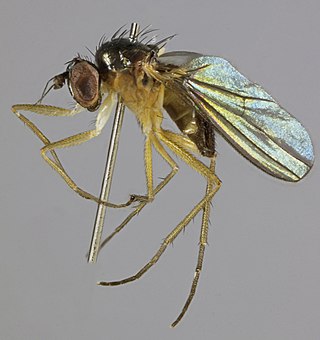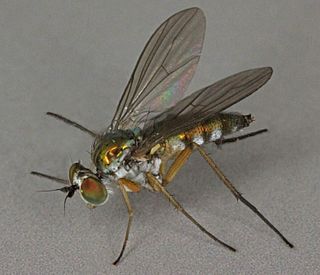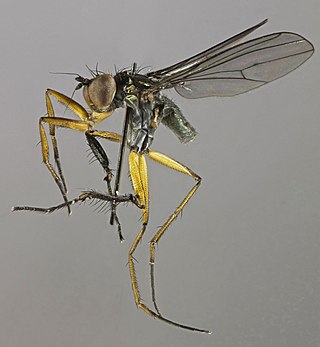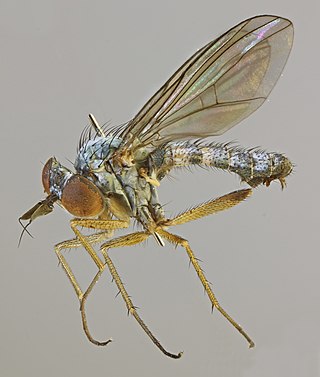Ortochile is a genus of flies in the family Dolichopodidae. It is distributed in the Western Palaearctic realm, including Europe, Turkey, Israel and North Africa. Adults of Ortochile have greatly elongated mouthparts, longer than the height of the head. They are associated with flowers, and have been reported to feed on nectar and pollen. Flower-feeding is also known in some species of Hercostomus.
Anahydrophorus is a genus of flies in the family Dolichopodidae. It contains only one species, Anahydrophorus cinereus. It is recorded from southern Spain and Portugal in Europe, and it is widely distributed along the coasts of North Africa.

Anepsiomyia is a genus of flies in the family Dolichopodidae. It contains only one extant species from Europe, Anepsiomyia flaviventris, as well as two fossil species from the Eocene of Russia and Belarus. The systematic position of the genus is currently uncertain: it has been variously placed in subfamilies such as Sympycninae and Peloropeodinae.
Palaeomedeterus is an extinct genus of flies in the family Dolichopodidae, known from Baltic amber and Cambay amber from the Eocene. The genus was first proposed by Fernand Meunier in 1895 with no included species or description, though illustrations were provided for six different unnamed species.

Sciapus is a genus of long-legged flies in the family Dolichopodidae. There are about 82 described species in Sciapus.

Syntormon is a genus of flies in the family Dolichopodidae. It includes about 110 species worldwide, more than 50 of which were described from the Palaearctic realm.

Thinophilus is a genus of flies in the family Dolichopodidae. It includes about 146 described species distributed worldwide. Most species of the genus are found in coastal habitats, while a few species are found in freshwater habitats.

Sympycninae is a subfamily of flies in the family Dolichopodidae. In some classifications, this subfamily includes the genera of the subfamilies Peloropeodinae and Xanthochlorinae.

Aphrosylus celtiber is a species of fly in the family Dolichopodidae. It is distributed in Western Europe.

Argyra argyria is a species of fly in the family Dolichopodidae. It is distributed in Europe and North Africa.

Argyra diaphana is a species of fly in the family Dolichopodidae. It is distributed in Europe, except for the south.

Campsicnemus curvipes is a species of fly in the family Dolichopodidae. It is distributed in Europe and North Africa.

Campsicnemus loripes is a species of fly in the family Dolichopodidae. It is distributed in Europe.

Campsicnemus scambus is a species of fly in the family Dolichopodidae. It is distributed in Europe, except for the south.
Prohercostomus is an extinct genus of flies in the family Dolichopodidae, known from Baltic amber from the Eocene. It was originally created as a subgenus of Hercostomus, but was later raised to genus rank.
Argyra leucocephala is a species of fly in the family Dolichopodidae. It is distributed in Europe, except for the southeast.

Argyra perplexa is a species of fly in the family Dolichopodidae. It is distributed in Northwestern Europe, Italy, Hungary and Portugal.

Argyra vestita is a species of fly in the family Dolichopodidae. It is distributed in Europe.
Nothorhaphium is a genus of flies belonging to the family Dolichopodidae. It includes four species from Australia and a single species from New Guinea. Nothorhaphium superficially resembles the genus Rhaphium, but it belongs in the subfamily Sympycninae and is thought to be closely related to the genera Syntormon, Parasyntormon and Ceratopos. The name of the genus is derived from the Greek νόθος, and Rhaphium.












